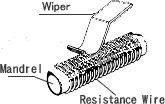Wirewound & Nonwirewound elements
A wirewound precision potentiometer resistive element is made up of turns of wire (red arrow) over a mandrel or core wire. A wiper (green arrow) contacts only a small portion of each turn. Wirewound elements are more stable under temperature change and have better linearity. Wirewound potentiometers are the better choice when used as a rheostat.
Nonwirewound elements - Conductive plastic & Hybrid.
Nonwirewound elements are characterized by the continuous nature of the resistance element in the direction of the wiper. Conductive plastic is a smooth conductive material, it has essentially infinite resolution. Hybrid elements offer a long rotational life and essentially infinite resolution. Hybrid elements are made with conductive plastic over a wirewound element.
Nonwirewound : Carbon Element
Carbon type elements are typically used in panel controls and MIL style potentiometers. The carbon elements are hot molded to a substrate similar to conductive plastic. Carbon elements feature infinite resolution and lower cost than conductive plastic. But have a lower life cycle.




